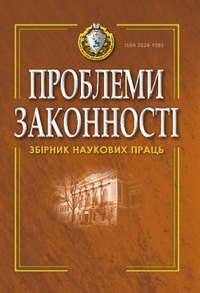How the European Court «judges» history (to the problem of judicial activism)
DOI:
https://doi.org/10.21564/2414-990x.129.52064Keywords:
judicial activism, judicial restraint, the evolutionary interpretation, the European Court of Human Rights, subsidiarity, «difficult cases»Abstract
Problem setting. It’s striking that even such seemingly distant from political speculations international jurisdictional authority, as the European Court of Human Rights has nolens volens to give not only a legal qualification of the alleged violations, but also a legal assessment of the historical facts presented by the parties or by the Court office. It is significant that this kind of assessment can cause violent reactions, sometimes even more bitter than that which concerns the violation. In the analysis of such cases, referred to as «sensitive», we see the purpose of this article. It should be emphasized that this topic has never been covered in the domestic legal literature.
Recent research and publications analysis. It should be pointed out that these estimates are given by the High Court is not arbitrary, and in the context of another, much broader phenomenon, called «judicial activism». In relation to the activities of the European Court identified the phenomenon manifests itself in several forms. First, it can occur when the Court has several options for interpretation in the framework of its case-law, but it goes beyond that - and then his choice has legal effect, destroying the value of the previous precedents.
Secondly, it is not always a clear position on procedural matters, as it was in the «Katyn case» (Janovec and others v. Russia). Then the Court was confronted with an event that took place not only before the ratification of the Convention by the Respondent state (1998), but even before it was born (1950), which was indicated in the dissent of the judge from Ukraine Yudkivska. As a general rule, the Court would have had to reject filed a claim as not corresponding to the criteria ratione temporis, however, the proceedings were not only open, but also culminated in the decision of the full decision, according to which Russia pledged to pay significant compensation to the relatives of the victims. In many respects the situation is similar, but with opposite sign was observed in the case of “Liechtenstein Prince Hans-Adam II against Germany». In the resolution it was stated that the expropriation of the property of the father of the applicant, including expensive paintings P. van Laere «lime Kiln», was carried out by the authorities in the former Czechoslovakia in 1946, that is, until September 3, 1953, when entered into force, the Convention, and before may 18, 1954, when he joined the force of Protocol No. 1 to the Convention. Accordingly, the European court declared itself incompetent ratione temporis to examine the circumstances of the expropriation and its consequences (§ 85 rulings of 12 July 2001). However, in the next paragraph the Court actually decides the issue on the merits, stating that the decisions of the courts of Germany and the subsequent return of the paintings in the Czech Republic can not be considered as interference in the «property» of the applicant within the meaning of article 1 of Protocol No. 1 to the Convention.
And finally, third: judicial activism can be seen in the revision of certain facts and events of history, sometimes leading to incorrect or doubtful legal conclusions. The last form of judicial activism and is of greatest interest to us.
Conclusions. However, in some «sensitive» cases the Court will deal with the circumstances not only recent, but also very distant past. In such cases, the question arises: should it be avoided at all costs for the review of cases that have a strong impact (geo-) politics, thereby substituting the OSCE and the International Court in the Hague, or does it have its regulations to allow the correction of the effects of the turbulent history of Europe ?
References
Afanas'ev, D. V. (2012). Podacha zhaloby v Evropejskij sud po pravam cheloveka. Moscow: Statut, 606.
Bereza, A. (2015). Nash Stalingrad. Novoe vremja, 2, 16–26.
Butkevych, V. G. (Ed.) (2011). Deklaracija Konferencii' vysokogo rivnja pro majbutnje Jevropejs'kogo sudu z prav ljudyny. Jevropejs'kyj sud z prav ljudyny. Sudova praktyka. Issue 2: in 3 books. Book 1. Kyiv: Pravo Ukrai'ny, 148–156.
Evseev, A. Semantika voennoj propagandy (na primere antiterroristicheskoj operacii v Slavjanske). Available at: http://psyfactor.org/psyops/propaganda23.htm
Kovler, A. I. (2010). Posle «Kononova». Prava cheloveka. Praktika Evropejskogo suda po pravam cheloveka, 9, 6–12.
Kovler, A. (2010). Scilla i Haribda Evropejskogo Suda: subsidiarnost' ili pravovoj aktivizm? Sravnitel'noe konstitucionnoe obozrenie, 6, 90–100.
Kolisnyk, V. P. (2008). Politychna kul'tura ukrai'ns'koi' elity v konteksti spryjnjattja skladnyh etapiv vitchyznjanoi' istorii'. Politychna kul'tura suspil'stva: dzherela, vplyvy, stereotypy: zbirnik statey i tez za materialamy vseukrainskoi naukovo-praktichnoi konferentcii. XX Kharkivski politologichni chytannja. Kharkiv: NJuAU, 169–172.
Kononov, V. M. (2014). Tri moih vojny. Moscow: Molodaja gvardija, 315.
Lukashuk, I. I. (2001). Mezhdunarodnoe pravo: uchebnik. Vol. 2: Osobennaja chast'. Moscow: BEK, 456.
Reling, B., Kasseze, A. (2015). Za kulisami Tokijskogo processa: razmyshlenija «podzhigatelja mira». Kharkiv: Jurajt, 192.
Sovmestnoe sovpadajushhee mnenie sudej A. Kovlera i G. Judkovskoj po delu «Janovec i drugie protiv Rossii» (2013). Mezhdunarodnoe pravosudie, 1, 120–123.
Butkevych, V. G. (Ed.) (2011). Sprava «Gongadze proty Ukrai'ny». Jevropejs'kyj sud z prav ljudyny. Sudova praktyka. Issue 2: in 3 books. Book 2. Kyiv: Pravo Ukrai'ny, 48–89.
Stankov i Ob'edinennaja organizacija Makedonii «Ilinden» protiv Bolgarii. Available at: http://www.lawtrend.org/wp-content/uploads/2014/03/Stankov1.pdf
Timofeev, M. (2013). «Janovec i drugie protiv Rossii»: katynskaja tragedija v prokrustovom lozhe sudebnyh reshenij. Mezhdunarodnoe pravosudie, 4, 4–10.
Tumanov, V. (2003). Avtonomnoe tolkovanie ponjatij v praktike Evropejskogo suda po pravam cheloveka. Konstitucionnoe pravo: vostochnoevropejskoe obozrenie, 3, 78–84.
Kovler, A. (2011).La Courdevant l’Histoire, l’Histoire devantla Courou commentla Coureuropéenne «juge» l’Histoire. La Conscience des droits. Mélanges en l’honneur de Jean-Paul Costa. P.: Dalloz, 337–352.
Downloads
Published
How to Cite
Issue
Section
License
Copyright (c) 2015 О. П. Євсєєв

This work is licensed under a Creative Commons Attribution 4.0 International License.










